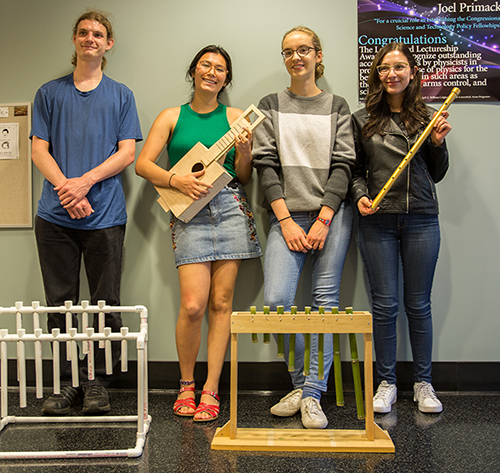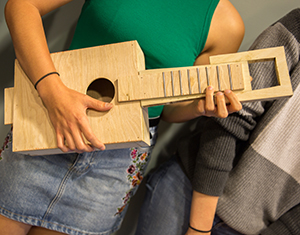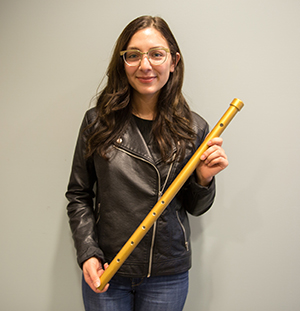Campus News
Instruments of good
Introductory physics students test their knowledge and get exposure to the wider world in a class project in which they create musical instruments to be donated to kids in need.



When it came time to complete her Physics 6B final project, UC Santa Cruz student Asia Stautz turned to an unlikely set of tools.
“I used a band saw, metal files, a nail gun, and wood glue,” said the Crown College human biology major, showing off the end result: a cool-looking, handmade ukulele crafted out of recycled wood.
The instrument was a test of Stautz’s knowledge of standing sound waves and musical acoustics, and had to be capable of playing a simple tune. But it also was a lesson in giving. The instrument—part of a class project designed by lecturer Stephanie Bailey—will later be donated to a small school in an outlying province in the Philippines.
The project, said Bailey from her office on Science Hill, was a way not only to test what her 250 introductory physics students—most of them life science majors—have learned, but also to expose them to the larger world.
“An objective of mine has been to incorporate service learning where you can take advantage or piggyback on the learning goals of the classroom and combine community service in a way that both enhances the educational experience of the students and also brings benefit to the community,” Bailey said.
For Stautz, who hopes to become an obstetrician, the project meant long hours of planning and ingenuity. Without tools or materials, she talked her way into the campus woodshop, promising volunteer sweeping and cleanup hours in exchange for a chance to raid the scrap bin and use the shop’s tools.
For Rachel Barocio, a Rachel Carson College molecular, cell and developmental biology major who plans to go on to graduate school, a discarded piece of PVC pipe was turned into a bronze-painted flute. It was, she said, an opportunity to use her artistic side.
“I enjoyed it (the project) because I consider myself a creative person, and, in sciences, there often can be a lack of creativity,” she said.
According to Bailey, there has been no lack of creativity and sophistication in her students’ designs, which range from a thumb piano to James Egan’s drum/xylophone made out of PVC pipe.
A computer science major from Rachel Carson College, Egan said his inspiration came from a video posted by the famed Blue Man Group and that he learned more than just physics from his project.
“I learned it’s good to start early and to prototype and plan,” Egan said. “Then there’s the ‘measure twice and cut once’ lesson and, one step beyond that, to glue once.” He grinned.
Tatjana Beck, an ecology and evolution major at Rachel Carson College, found trial and error and a table saw to be important parts of her project. Testing materials like copper, aluminum, and PVC pipe, she finally settled on bamboo to create a vertical xylophone and then had to experiment with the wood’s range of thick and thin to come up with something that could actually play a tune.
The fact the instruments have to be functional is important, not only for grades, but also for about 60 preschool through sixth-grade students at the Prestige Montessori School in Maasin City in Southern Leyte in the Philippines who will be receiving the finished products.
“The kids will love them,” said UC Santa Cruz Physics Professor David Belanger who, along with his wife, Melca Belanger, built and now support the small private school.
Many of the schools in the area can’t even afford books, according to Belanger. So the gift of musical instruments, along with knowing that they came from university students, will be a treat for the children, he said.
“I think we’re all in positions to help others and make a difference,” Bailey said. “I have this greater goal that I would like my students to leave the world a better place than they found it.”